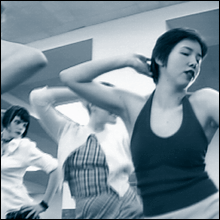![[Sidebar]](/standard/image/sidebar.gif)
![[Movie Reviews]](/standard/image/headers/movie_reviews_header.gif)
| by movie | by theater | hot links | reviews |
New views
The RISD Fest abounds with innovation and happy accidents
by Mike Miliard
THE 2001 SENIOR FILM/ANIMATION/VIDEO FESTIVAL. At the RISD Auditorium through May 26.
Margret Wuller's Automaton
At a time when photorealistic computer animation looks to have aims toward supplanting celluloid (e.g., Shrek, the upcoming Final Fantasy), it's heartening to see that there are still animators for whom verisimilitude is not the ultimate objective, who embrace abstraction and caricature and revel in the chaotic messiness, the happy accidents, and the boundless expressive possibilities of "real" media. Such works are a welcome part of the Rhode Island School of Design's 2001 Senior Film/ Animation/Video Festival.Tim Miller's Tide Pool, for instance, is a lo-fi but high-energy stew of line and shape, color and black and white, geometric and organic forms. The mix is haphazard at times, but at its best the short resembles a de Kooning painting sprung to vibrant life. Margret Wuller's Automaton uses a similar commingling of media to express mood. Shaky line drawings of a moribund-looking figure, enduring the daily routine that is the bane of so many lives -- an endless repetition of showers, commutes and coffee breaks -- are superimposed on stark black and white footage of cityscapes and teeming masses of workers. The images fade in and out of each other, building in a slow crescendo of frustration and rage.
Christina Gruppuso's 1000 Marys, on the other hand, is sublime, a lightning-fast montage of one of art's most recognizable images. Her film focuses on the delicately rendered hands, eyes, and lips of hundreds of paintings of the Virgin, taken from Byzantine art through modernism. By choosing works whose compositions roughly correspond, she creates the illusion of motion -- a gentle undulation that enlivens the warm hues and placid expressions of the serene mother and child.
Ben Howell's Trevor / Tape 1
In Boneyard Brawl, Jennifer Tanguay does the opposite, using muscular lines and an abrasive chiaroscuro to give dramatic tension to, well, a boxing match between skeletons. John Bonarrigo's Triple Double Trouble also uses the kineticism of stop-motion scribbles to convey the élan of basketball and the violent agitation of punk rock. And in the claymation Wet Appetite, Mike Randoll sculpts figures whose goofy caricatured faces resemble those of Aardman Animation. Then he subjects them to some "fishy" atrocities that would make Wallace and Grommit wretch.Of the live-action works, the best by far is Ben Powell's Trevor / Tape 1. Charging the film's characters and its viewers to "take a step back and remove yourself from your own experiences and just watch, as if you're watching someone else instead of experiencing things yourself," Powell creates an epiphanic glimpse at the barely-noticed minutiae of daily life. A murmured voice-over, hardly discernable, is played over a series of perfectly composed shots: school interiors, traffic lights, a perpetually rising escalator. With this intense scrutiny, Powell creates a hypnotizing, transcendent experience wherein the smallest things -- the sound of a mop slopping on the floor, the individual spaces concealed by a row of lockers, the development of a Polaroid photo -- assume great significance.
Luke Altenau evinces a similar knack for composition. The Underground borrows the split screen quadrant technique pioneered by Mike Figgis in Time Code. And, despite suffering from the drug-induced psycho-babble spouted by its main character, the work is technically proficient. Its four sharp-focus screens play off each other, evoking the chaos of a gigantic rave, and the fractured cognitive process that occurs when "within the quiet of a hotel room Eric discovers the drugs he took are still working."
Andrew Potkonjak's American High School Virgin Zombie Nightmare
In The Broadcast, Lance Herrington sabotages some vintage 1980s TV footage: a Gobots episode, toy and breakfast cereal commercials. At first, it seems like a normal Saturday morning on the family room rug. Then things get weird. Suddenly Teddy Ruxpin is singing about childhood self-loathing. A toy soldier commands his men (with liberal doses of profanity) to ransack and burn an enemy village. Like Negativland's gleeful skewerings of the media and corporate America, Herrington's work is funny and a little unsettling. And, like Negativland, he should be careful he doesn't get sued.In Wicked Awesome High, Johanna Jenkins looks at adolescence with a skillful send-up of the half-hour teen show. It opens with a spot-on goof on the archetypal Dawson's Creek/90210 opening credit sequence: gelled-up guys in khakis and Gap-clad girls horse around with each other in front of a drop cloth, then grin demurely when it's time for their close-ups. The episode has its moments, but falters at time thanks to (intentionally?) wooden performances and a script that doesn't push its parody far enough.
But American High School Virgin Zombie Nightmare revels in its supreme badness. It's about . . . well, you figure it out. Andrea Potkonjak's production takes the viewer to hell and back, resembling a woefully off-key Jesus Christ Superstar or Rocky Horror Picture Show, a spectacular mess of shambling choreography, off-kilter lip-syncing, and gloriously bad singing. In short, it's brilliant -- a film that would make Rock 'n' Roll High School director Allan Arkush (and the late, lamented Joey Ramone) proud.
| home page | what's new | search | about the phoenix | feedback |
Copyright © 2001 The Phoenix Media/Communications Group. All rights reserved.


